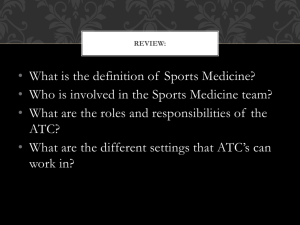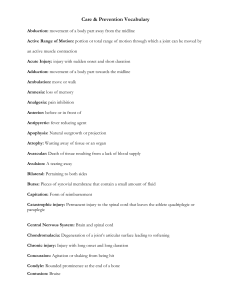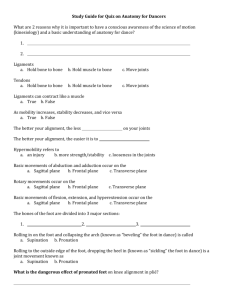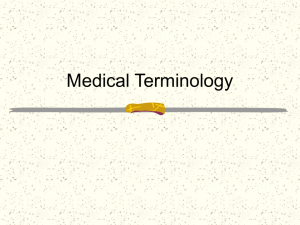Anatomical Terminology - Chandler
advertisement
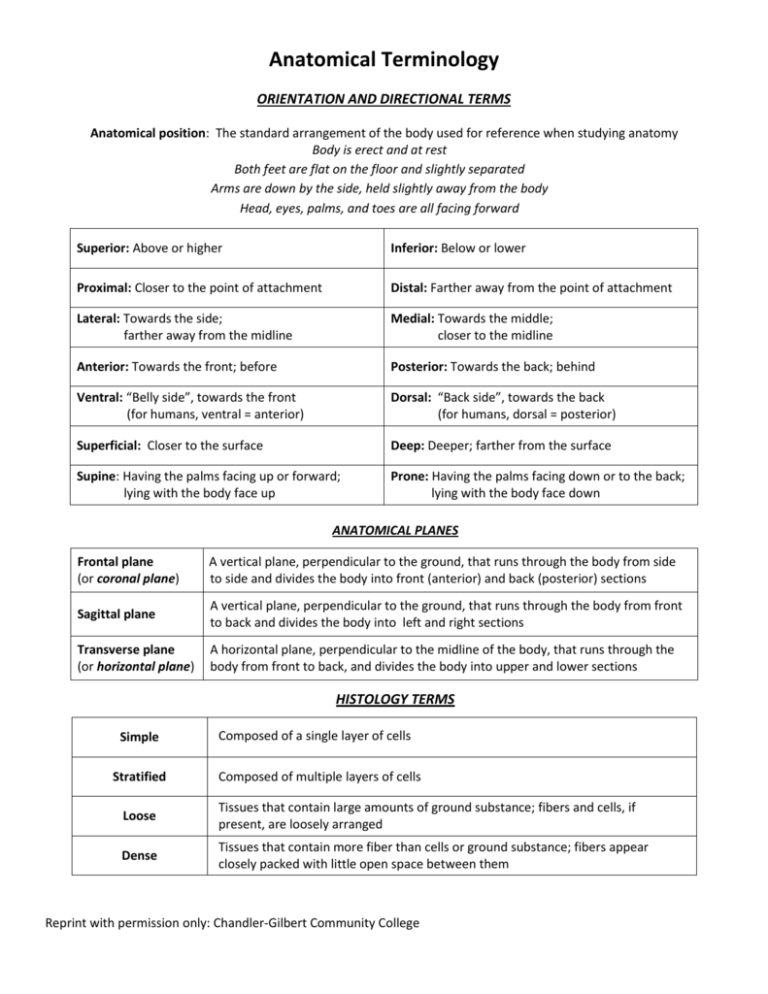
Anatomical Terminology ORIENTATION AND DIRECTIONAL TERMS Anatomical position: The standard arrangement of the body used for reference when studying anatomy Body is erect and at rest Both feet are flat on the floor and slightly separated Arms are down by the side, held slightly away from the body Head, eyes, palms, and toes are all facing forward Superior: Above or higher Inferior: Below or lower Proximal: Closer to the point of attachment Distal: Farther away from the point of attachment Lateral: Towards the side; farther away from the midline Medial: Towards the middle; closer to the midline Anterior: Towards the front; before Posterior: Towards the back; behind Ventral: “Belly side”, towards the front (for humans, ventral = anterior) Dorsal: “Back side”, towards the back (for humans, dorsal = posterior) Superficial: Closer to the surface Deep: Deeper; farther from the surface Supine: Having the palms facing up or forward; lying with the body face up Prone: Having the palms facing down or to the back; lying with the body face down ANATOMICAL PLANES Frontal plane (or coronal plane) A vertical plane, perpendicular to the ground, that runs through the body from side to side and divides the body into front (anterior) and back (posterior) sections Sagittal plane A vertical plane, perpendicular to the ground, that runs through the body from front to back and divides the body into left and right sections Transverse plane (or horizontal plane) A horizontal plane, perpendicular to the midline of the body, that runs through the body from front to back, and divides the body into upper and lower sections HISTOLOGY TERMS Simple Stratified Composed of a single layer of cells Composed of multiple layers of cells Loose Tissues that contain large amounts of ground substance; fibers and cells, if present, are loosely arranged Dense Tissues that contain more fiber than cells or ground substance; fibers appear closely packed with little open space between them Reprint with permission only: Chandler-Gilbert Community College SKELETAL SYSTEM TERMS Articulations A rounded process that articulates with another bone Condyle Facet A small, often flat surface that articulates with another bone Head An enlargement at the end of a bone, usually articulating with another bone Suture Interlocking junction between cranial bones Depressions and Openings Foramen (plural: foramina) Fossa (plural: fossae) An opening for the passage of blood vessels and/or nerves A shallow depression or cavity A tiny pit or depression Fovea Meatus (plural: meatus, meatuses) A tube-like passageway within a bone Notch A depression from one side of a bone to another Sinus A recess, cavity or hollow space within a bone Raised Features Crest A prominent border or ridge A smaller projection situated above a condyle Epicondyle A narrow, line-like ridge (less prominent than a crest) Linea A prominent projection of a bone Process Ramus (plural: rami) A branch-like process Spine A sharp, slender ridge Trochanter A relatively large, blunt projection of bone (found only on the femur) Tubercule A small, knob-like process (usually smoother than a tuberosity Tuberosity A larger, roughened, knob-like process or thickened area of a bone MUSCULAR SYSTEM TERMS Ligament Tendon Aponeurosis A band of connective tissue that connects bones to each other A band of connective tissue that connects muscles to bones A broad, flat sheet of connective tissue that anchors a muscle or connects a muscle to the part it moves Origin The point of attachment of a muscle that moves the least when the muscle is contracted Insertion The point of attachment of a muscle that moves the most when the muscle is contracted Reprint with permission only: Chandler-Gilbert Community College




